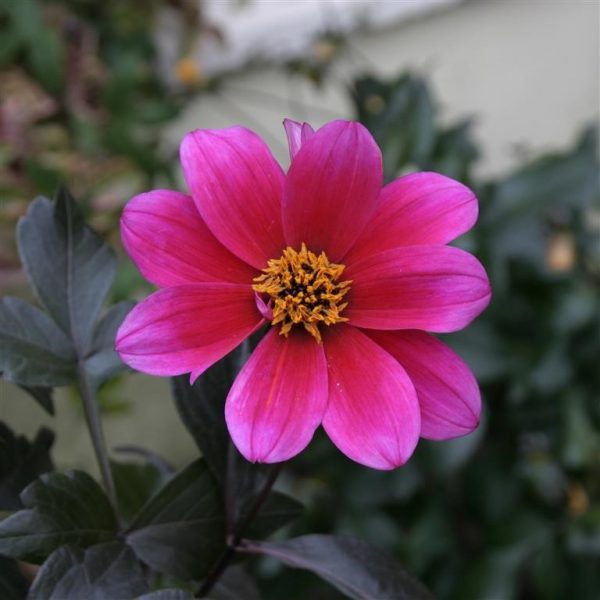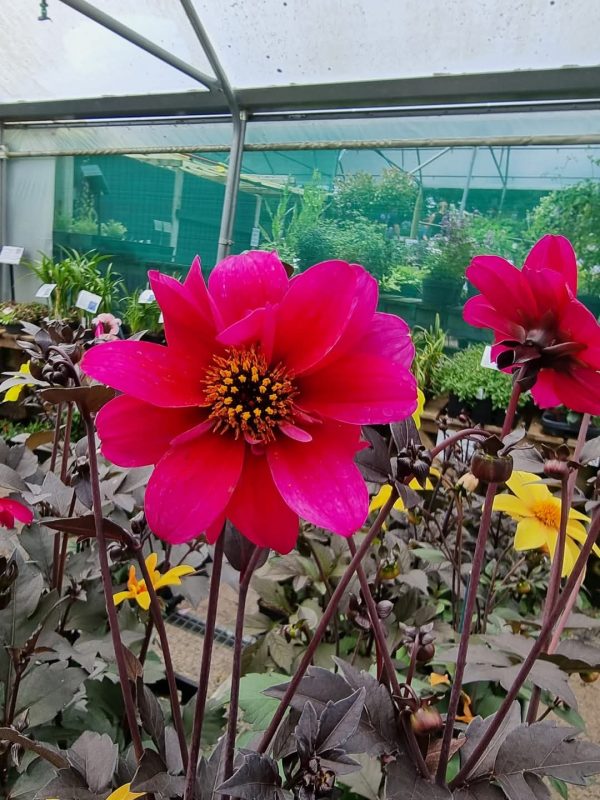PLEASE NOTE: YOUR PLANT WILL BE SUPPLIED CUT BACK
Dahlia ‘Bishop of Canterbury’
£6.45
A superb dahlia with vivid cerise-purple flowers over dark foliage. Height 90cm. Spread 75cm. Flowers July to October. Full sun, moist, well-drained soil. Mulching recommended in winter.
Description
Dahlia ‘Bishop of Canterbury’ is a stunning dahlia variety known for its vivid cerise-purple flowers and dark foliage, adding vibrant colour and elegance to any garden. Follow this comprehensive planting guide to ensure your Dahlia ‘Bishop of Canterbury’ thrives and produces an impressive show of blooms from July to October.
PLANTING and AFTERCARE GUIDE
Best Planting Time
Spring: The optimal time to plant Dahlia ‘Bishop of Canterbury’ is during the spring, once the soil has warmed and the threat of frost has passed. This gives the tuber enough time to establish strong roots before the summer growing season, promoting healthy growth and plenty of vibrant flowers.
Late Spring: If the weather is cooler, wait until late spring to plant your Dahlia ‘Bishop of Canterbury’ to ensure it gets a good start without the risk of frost. Planting in late spring allows the plant to grow through the summer and continue blooming into autumn.
Site Selection
Sunlight: Dahlia ‘Bishop of Canterbury’ thrives in full sun. Choose a location that receives at least 6 hours of direct sunlight daily to ensure strong growth and abundant blooms. In areas with partial shade, it may still flower but may not reach its full potential.
Soil: Well-drained, fertile soil is essential for Dahlia ‘Bishop of Canterbury’. Ensure the soil is not waterlogged, as this can lead to root rot. Improving the soil with organic matter like compost will enhance its drainage and provide the nutrients necessary for your dahlia to thrive.
Planting Instructions
- Prepare the Hole: When planting your Dahlia ‘Bishop of Canterbury’, dig a hole approximately twice the width and the same depth as the tuber. This gives the plant enough room for its roots to spread and grow.
- Soil Preparation: Mix compost or organic matter into the soil to improve its fertility and drainage. This will help the Dahlia ‘Bishop of Canterbury’ grow strong and produce vibrant flowers.
- Planting the Tuber: Place the tuber in the hole with the growing buds facing upwards. Cover the tuber with soil and gently firm the soil around it, making sure to remove any air pockets. Be careful not to bury the tuber too deeply, as it needs to be close to the surface.
- Watering After Planting: Water the Dahlia ‘Bishop of Canterbury’ thoroughly after planting to settle the soil around the tuber. Make sure the soil drains well to avoid waterlogging, which can damage the roots.
Watering Requirements
Growing Season: Dahlia ‘Bishop of Canterbury’ requires regular watering during its growing season, especially during dry spells. Water deeply, allowing the soil to dry slightly between waterings. Avoid overwatering, as excess moisture can lead to root rot.
Dormant Season: During the dormant season, reduce watering significantly. Dahlia ‘Bishop of Canterbury’ needs minimal moisture at this time. Only water if the soil becomes extremely dry.
Feeding
Spring: Apply a balanced, slow-release fertiliser in early spring to give your Dahlia ‘Bishop of Canterbury’ the best start to the growing season. This will support vigorous growth and abundant flowering.
Mid-Summer: A light feeding during mid-summer can encourage continued blooms. Use a fertiliser with a higher phosphorus content to promote strong flowers and enhance bloom production.
Pruning
Deadheading: Regularly deadhead spent flowers on your Dahlia ‘Bishop of Canterbury’. This helps encourage the plant to produce more blooms and keeps the plant looking tidy throughout the growing season.
Autumn Pruning: After the final blooms of the season, cut the plant back to the ground to prepare it for winter. This helps promote healthy growth in the following year and protects the plant from pests and diseases during the dormant period.
Mulching
Spring: Apply a layer of mulch around the base of your Dahlia ‘Bishop of Canterbury’ to retain moisture, suppress weeds, and regulate the soil temperature. Organic materials like compost or bark chips work best for mulching.
Winter: In colder regions, apply additional mulch around the plant in winter to protect the tuber from freezing temperatures. This helps prevent frost damage and ensures the tuber survives until the next growing season.
Supporting the Plant
Staking: Dahlia ‘Bishop of Canterbury’ can grow tall and may require staking, especially if grown in windy areas. Install stakes early in the season to support the plant and keep its vibrant cerise-purple flowers upright.
Final Tips
Dahlia ‘Bishop of Canterbury’ is a low-maintenance, high-impact plant that will brighten your garden with its vivid cerise-purple blooms from July to October. By providing the plant with full sun, well-drained soil, and proper care throughout the growing season, you’ll enjoy a stunning show of flowers and foliage.
Additional information
| Pot Size |
|---|











Alistair (verified owner) –
Dawn (verified owner) –
Lovely plant can’t wait for next year’s show of colour !
georgie fry (verified owner) –
LYNDA (verified owner) –
Arrived in great condition with buds emerging
Anita S. (verified owner) –
Excellent condition, good value for money.